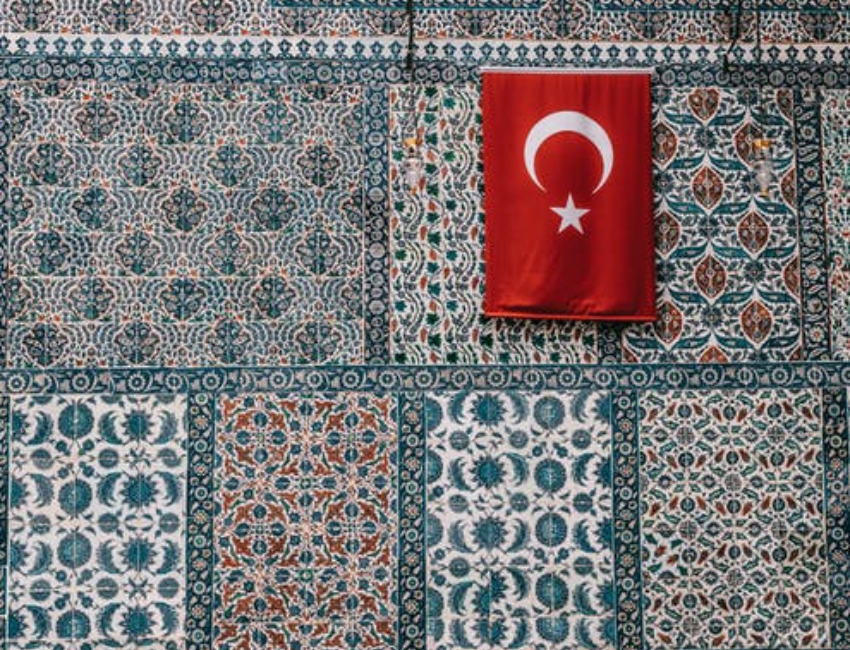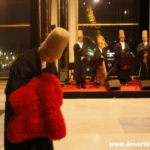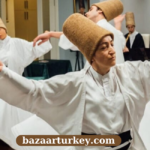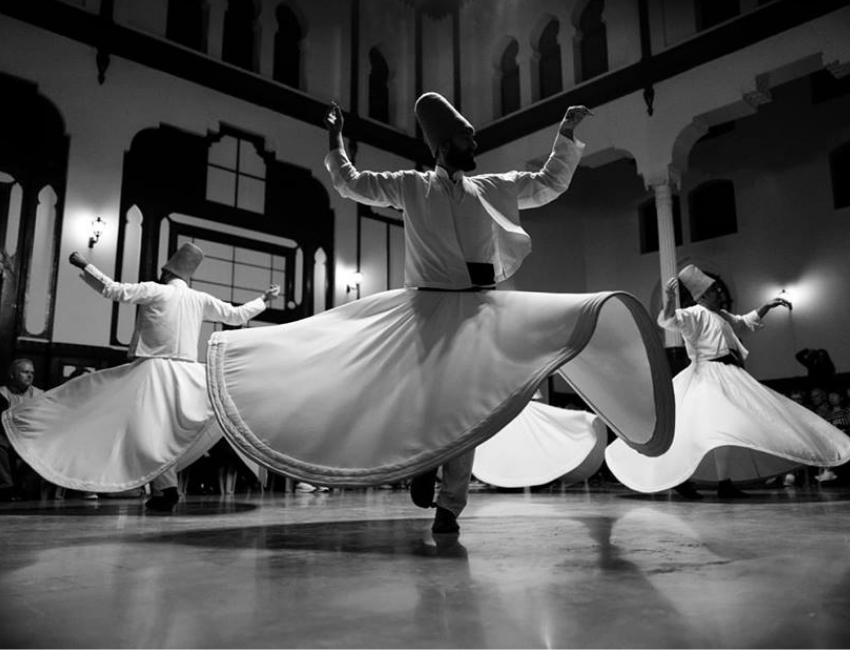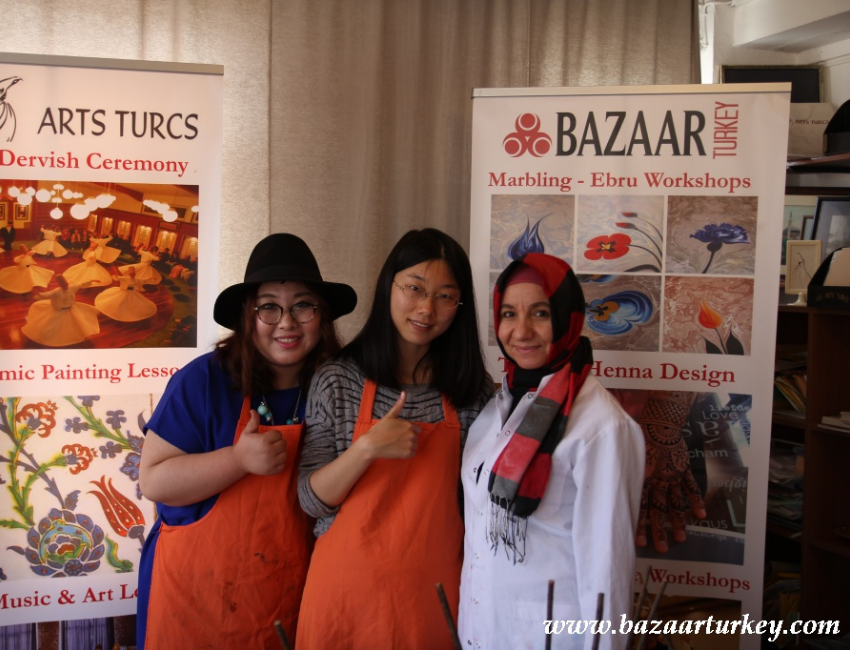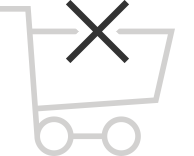Associate Professor Dr. Sitare Turan Bakir
Mimar Sinan University
Department of Traditional Turkish Arts
The art of Turkish tiles and ceramics occupies a place of prominence in the history of Islamic art. Its roots can be traced at least as far back as the Uighurs of the 8th and 9th centuries. Its subsequent development was influenced by Karakhanid, Ghaznavid, and (especially) Iranian Seljuk art. With the Seljuks’ victory over the Byzantines at Malazgirt in 1071, the art followed them into Anatolia and embarked upon a new period of strong development fostered by the Anatolian Seljuk sultanate.
The Anatolian Seljuks were of course influenced by the cultural heritage they encountered in their new homeland, adapting them to the techniques that they had brought with them from the Iranian plateau. This resulted in a distinctively Anatolian style of Seljuk architecture that was in full bloom by the 13th century. Seljuk mosques, medreses (theological academies), tombs, and palaces were lavishly decorated with exquisite tiles. Examples of such tile-clad structures can still be seen in the Seljuks’ capital city of Konya as well as in the cities of Sivas, Tokat, Beysehir, Kayseri, Erzurum, Malatya, and Alanya.
The most frequently-encountered type of architectural decoration during the Anatolian Seljuk period involved the use of glazed brick in which glazed (and also unglazed) bricks were arranged to produce a variety of patterns, mostly on the facades of buildings. Turquoise was the most frequently-used color for glaze although cobalt blue, eggplant violet, and sometimes black were also popular.
A type of architectural decoration used in conjunction with glazed brick was hexagonal, triangular, square, and rectangular monochrome tiles. Unlike brick, these were preferred for indoor registrations and were suitable for a multiplicity of geometrical arrangements. Tiles were made from a paste that was harder and more yellowish than that of bricks. Turquoise, cobalt blue, violet, and (sometimes) green glazes were used. There are rare examples with traces of gilding.
A third technique in which the Anatolian Seljuks were skilled was that of mosaic tile. This was also employed in interiors, especially in mihrab niches, the interiors of domes, transitions to domes, vaults, and walls. Tile mosaic is formed by pieces of tile cut to shapes to fit the pattern intended. The unglazed surfaces of the tesserae are slightly conical. The pieces were arranged glazed-side down after which a whitish mortar was poured over them. When it had set, the resulting plate or panel could be installed where desired. Mosaic-tile compositions are generally geometrical but floral motifs and Kufic or Thuluth calligraphy are also found. The most popular colors were turquoise, cobalt blue, eggplant violet, and black. Examples of Anatolian Seljuk buildings decorated with mosaic tile are Karatay Medrese (Konya, 1251), Alaaddin Mosque (Konya, 1220), Gok Medrese and Mosque (Sivas, 1271), the Malatya Grand Mosque (1247), and Ince Minareli Medrese (Konya, 1264).
In addition to these techniques, which, along with underglaze, appear in religious and funerary architecture, there were two techniques employed only in civil and palace architecture: minai tiles and luster tiles. The forms of these tiles were also different, the favorite shapes being stars and crosses; instead of geometric patterns, vegetal scroll and lively figurative compositions were used.
The minai technique was developed in Iran in the 12th and 13th centuries mainly in ceramics. The only place in Anatolia were tiles of this type have been found is Alaeddin Kiosk in Konya. The palette of colors that this technique offers is much greater and one finds shades of violet, blue, turquoise, green, red, brown, black, and white as well as gilding. Some colors were applied under the glaze and then fired; others were applied over the glaze which then received a secondary opaque white, transparent, or turquoise glaze and was fired again. The designs of minai tiles are lively and reminiscent of miniatures with themes taken from palace and court life.
In underglaze tiles, the designs are painted onto the surface, which is then glazed before the tile is fired. This was the technique most commonly used by the Anatolian Seljuks. The preferred colors were turquoise, cobalt blue, green, violet, and black. Instances of black-decorated tiles under a turquoise glaze are also found. Fine examples of these tiles have been discovered at the excavations of the Kubadabad Palace in Beysehir, where the tiles are decorated with plant motifs as well as with figures of human beings and animals.
The luster technique first appeared in Abbasid Iraq. Later developed to a high level by the Fatimids in Egypt, it was successfully employed by the Iranian Seljuks. The only place in Anatolia where luster tiles have been found is Kubadabad. The tiles discovered at the excavations of the palace are now on display at the Karatay Medrese Museum in Konya. Luster tiles are decorated in an overglaze technique in which the design is painted with lusterĞa mixture of metallic oxides incorporating silver and copperĞonto a previously glazed and fired surface. The tiles are then given a second firing at a lower temperature producing a range of lustrous, mostly brownish and yellowish tones. Seljuk palace luster tiles are decorated with plant motifs as well as with human and animal figures.
Anatolian Seljuks sometimes used square, rectangular, hexagonal, and triangular tiles to cover interior walls. These tiles are plain, with turquoise, violet, or cobalt blue being the chief colors applied in the underglaze technique. Sometimes the traces of overglaze gilding are to be found; however because the gilding was fired at a low temperature (or not fired at all), it was not durable and has mostly disappeared.
Excavations carried out in 1965-66 at Kalehisar near Alacahoyuk have revealed important evidence of the Seljuks’ ceramics industry in the 13th century. Two kilns were unearthed along with a substantial quantity of kiln material and incomplete and spoiled examples of ceramics decorated with the sgraffito and slip techniques.
In the sgraffito technique, the object is allowed to dry to leather-hardness after which the design, usually plant and floral motifs, is incised into the surface, which may or may not be given a coat of slip beforehand. The resulting design is then covered with a transparent glaze of a different color and then the piece is fired.
In the slip technique, the design is painted onto a red-paste surface using diluted white slip to produce a slightly molded effect. The surface is then given a coating of transparent glaze colored blue, green, or light or dark brown and then fired. During the firing, the areas decorated with slip assume a lighter shade of the glaze color, which appears darker in the ground. Motifs are stylized plant motifs and sometimes simple rumi (arabesque scroll).
Emirate-period tiles are generally a continuation of Seljuk techniques with one important exception: the introduction of the cuerda seca technique, which was subsequently developed by the Ottomans. The earliest examples of this group are dated to the late 14th and early 15th centuries. In this technique, a red paste is given a coating of white slip. The design is stamped or carved into the surface after which colored glazes are applied. The contours of the designs are picked out with a mixture of beeswax or vegetable fat and manganese oxide. During the firing, the wax or fat burns away producing contours of red or black that also prevent the differently-colored glazes from running into one another.
The cuerda seca technique permits extremely complex and detailed designs to be applied to ceramic surfaces. In addition to plant motifs, examples decorated with calligraphy and (less commonly) geometric patterns that are a continuation of Seljuk traditions are to be found. A rich and subtle palette of colors was available with colors such as turquoise, cobalt blue, lilac, yellow, black, and pistachio. Gilding was also used. Fine examples of cuerda seca tiles are to be found at the Bursa Green Mosque (1419-1420) and Tomb (1421-1422) the Mosque of Murad II (Edirne, 1436), the Tiled Kiosk (Istanbul), and the Tomb of Prince Mehmed (Istanbul, 1548).
Sgraffito and slip-decorated wares continuing Seljuk techniques and styles were also produced during the Emirate period. During early Ottoman times, they appear among Iznik wares reflecting the tastes of folk art.
In the course of excavations at the site of ancient Miletus, the archaeologist and art historian F. Sarre came across a type of polychrome pottery that erroneously became known as ‘Miletus ware’. We now know, as a result of recent excavations, that these wares were actually made in Iznik. These red-paste ceramics appear during the second half of the 14th century. They are decorated with motifs executed in tones of blue, turquoise, and violet under a colorless or colored glaze. Examples in which the motifs have black contours are also known, as are pieces with black decorations under a turquoise glaze. The principal forms are bowls and dishes. A feature of most ‘Miletus’ ware is that the interiors are given a coating of slip but part of the exteriors and the bases are not. Designs tend to be plant motifs and geometrical arrangements but animal figures are also encountered. Most compositions suggest the influence of the designs found on metal wares. One, a composition of thick motifs radiating around a central motif, is identical to the grooved designs on metal bath-bowls.2
The late 15th and early 16th century marks the beginning of a new period in Ottoman tile and ceramic-making. The most important center active at this time was Iznik. Designs prepared by artists who were employed in the studios of the Ottoman court were sent to Iznik to be executed in wares ordered for use at the palace. The court’s patronage stimulated and supported the development of an artistically and technically advanced ceramic industry in Iznik.
The earliest example of the new styles that emerged in the early Ottoman period are the ‘blue-and-white’ Iznik ceramics. The techniques involved in their manufacture are quite advanced as compared with anything previously done. The pastes are quite hard, pure white, and of fine quality. In an analysis that appeared in his report of the 1981-82 excavations, Dr Ara Altun noted that these ceramics must have been fired at temperatures as high as 1,260 degrees Celsius rather than the normal 900 degrees adding that, at such temperatures, one is in the realm of light porcelain.3 The techniques and quality employed in these ceramics were to last through various changes in style until the middle of the 17th century.
During the late 15th and early 16th centuries, Iznik was producing far more in the way of blue-and-white wares than the wall tiles for which it was later to become famous. The styles, designs, decorations, and techniques of these ceramics are quite distinct from Seljuk traditions. These changes in the Iznik potters’ production habits are attributed to attempts to imitate the 15th-century Ming porcelains that were reaching the Ottoman court in various ways. The glazes are limpid and there is no crazing. The designs, which are given thin contours of slip, are executed and painted flawlessly. Shades of cobalt blue dominate but turquoise also appears here and there. The decorations include stylized foliage, arabesques, and Chinese clouds alone or in skillfully-executed compositions.
Iznik blue-and-whites can be classified in a number of subgroups on the basis of their motifs and styles. One group, with motifs consisting of stylized lobed leaves with curling tips is attributed to a ‘Baba Nakkas’, a chief designer at the Ottoman court studios in the 15th century, and is therefore known as the Baba Nakkas style .4 Cobalt blue in various tones is the principal color. Much later, small touches of turquoise also appear.
Another blue-and-white group from Iznik is erroneously called ‘Golden Horn ware’ because the first examples of it were discovered at a site on the Golden Horn in Istanbul. J. Raby has proposed calling them the ‘Tugrakes spiral style’ instead.5 The motifs of tiny leaves and flowers on spirals are executed in shades of cobalt blue, turquoise, and black.
Blue-and-white architectural tiles are rather rare but do exist. The forms are usually hexagonal. Examples are to be found in Edirne at the Mosque of Murad II (1436) and the Uc Serefli Mosque (1437-1448); in Bursa in the tombs of Prince Ahmed (1429), Prince Mustafa (1474), and Prince Mahmud (1506); and in parts of Topkapi Sarayi in Istanbul.
Iznik is also where another misnamed group of ceramics known as Damascus ware was manufactured. These ceramics are dated to around the middle of the 16th century. The forerunner of the style is said to be a lamp in the Dome of the Rock that is dated 1549 and bears the signature ‘Musli’. In this object we find a new palette of colors incorporating, in addition to the traditional cobalt blue and turquoise, eggplant violet and a cumin green. During this period, naturalistic such as tulips, roses, pomegranates and hyacinths begin to enrich the repertoire of stylized plant motifs and arabesques. During the second half of the 16th century, the transition to polychrome wares took place. The only examples of Damascus-ware architectural tiles that are known are those in the Mosque of Hadim Ibrahim Pasa (Silivrikapi, 1551) and in the Yeni Kaplica spa in Bursa (1552-3).6
Yet another group of polychrome underglaze Iznik ceramics to be erroneously attributed to another place is the one misleadingly known as Rhodos wares, so-called because of the numerous examples of them purchased from the island of Rhodes and taken into the Cluny Museum. Dr Oktay Aslanapa’s excavations at Iznik have demonstrated incontrovertibly that these wares were manufactured there. These ceramics have an extensive palette and are generally decorated with naturalistic flowers.
As late as the middle of the 16 century, the Ottoman ceramic industry was producing more utensils than architectural tiles. Thereafter however production shifted heavily in favor of the latter as there was a strong surge in the demand for tiles as decorations in the extensive building programs undertaken by Suleyman I (1520-1566) and his successors when the Ottoman Empire was politically, economically, and culturally at its peak. Countless examples of mosques and tombs not only in Istanbul but all over the empire were adorned with the products of the Iznik potters’ skill.
These underglaze-decorated ceramics and tiles were decorated with a rich palette of shades of cobalt blue, turquoise, green, black, brown, and the famous ‘coral’ or tomato red, the last of which appears in a slight relief resembling sealing-wax. In tiles, this red appeared for the first time in Suleyman I’s great mosque, the Suleymaniye (1557), in Istanbul.7 But other tiles in the same style were to grace numerous monuments erected in Istanbul during the years that followed: the Tomb of Hurrem Sultan (1558), the Mosque of Rustem Pasa (1561), the Tomb of Suleyman I (1566), the Mosque of Sokullu Mehmed Pasa (1572), the Mosque of Piyale Pasa (1573), and the Valide Atik Mosque (Uskudar, 1583).
Although the traditional designs of stylized plant motifs, arabesques, and Chinese clouds appear in the compositions, there is a shift towards a more naturalistic style in which tulips, carnations, hyacinths, roses, spring blossoms, lilies, cypress trees, and clusters of grapes and vine leaves appear. Compositions are relaxed and free, offering greater scope for experimentation with new and richer arrangements. (figure 10). Different styles of calligraphy adorn the tile friezes on monuments; on utensils we find images of ships, ‘rock-and-wave’ motifs, triple-spots, animal figures, and fish-scale patterns. There is also a proliferation in vessel forms of which deep and footed bowls, vases, ewers, dishes, lamps, candle-holders, and mugs are but a few.
Around the middle of the 17th century, the quality of the Iznik potteries began to feel the impact of the economic distress and political upheavals from which the Ottoman Empire had begun to suffer. Colors become dull, the famous tomato red turns brown and even disappears entirely. Designs become crude and are haphazardly executed. Pastes become coarse and glazes suffer from cracking. During this period the Iznik manufactories apparently turned their attentions more and more to the demands of customers who were less finicky than the Istanbul court and its circles. There is even evidence, in the form of written complaints, that orders placed by the court in Istanbul were being delayed.8
By the 18th century, the ceramic industry in Iznik had died out completely and Kutahya replaced it as the leading center in western Anatolia. Indeed, Kutahya had been in operation as a secondary center along with Iznik since the 14th century 9 but its production always paled in Iznik’s brilliance. But where production at Iznik was discontinued, Kutahya plodded on.
For a while, the Kutahya potters produced inferior copies of Iznik blue-and-whites but they also began producing ceramics whose forms, colors, and techniques are quite distinct. Among them are a group of Christian liturgical utensils and tiles with religious themes that were made by Armenian potters for their churches.
18th-century Kutahya ceramics are made with a white paste and are usually decorated with underglaze-applied designs in yellow, red, green, cobalt blue, turquoise, black, and violet. The designs are freely executed. In addition to polychrome wares, examples of blue-and-whites are also encountered. Forms, which can be elegant, include thin-walled small cups, saucers, bowls, ewers, pitchers, flasks, incense-burners, lemon-squeezers, and ornamental eggs.
During the first half of the 19th century, Kutahya’s ceramics industry suffered a downturn from which it slowly recovered during the second half and into the early part of this century. Thus do we find examples of Kutahya-made tiles decorating a number of late-Ottoman buildings. The tiles on the Tomb of Sultan Mehmed Resad V in Eyup (Istanbul, 1918) for example were made at the manufactory of Hafiz Emin Usta, which was then operating in Kutahya. Many examples of Kutahya ceramics from this period are to be found in museum and private collections in Turkey.
The difficult straits into which the Iznik industry had fallen in the 18th century inspired some in Istanbul to establish a reliable source of tiles that was closer to home and easier to control. Ibrahim Pasa, a grand vizier during the reign of Ahmed III (1703-1730), had a tile-making factory set up at Tekfur Sarayi in Istanbul. The output unfortunately was incomparably inferior to that of Iznik: designs were poor copies of Iznik originals, glazes had a blue cast and were flawed, and colors were dull and lifeless. Tile manufacturing at Tekfur Sarayi lasted thirty years or so and the enterprise was generally regarded as a failure. Nevertheless some of its output was used in buildings in Istanbul such as the Hekimoglu Ali Pasa Mosque (1734), the Yeni Valide Mosque (Uskudar, 1708), the Cezeri Kasim Pasa Mosque (Eyup, a restoration done in 1726 of a mosque originally built in 1515), and Kandilli Mosque (1751). There is also a hearth, now in the Victoria and Albert Museum in London, whose tiles were made at Tekfur Saray.
There is a third important group of Turkish ceramics that are quite different from both the sublime products of Iznik and the humbler wares of Kutahya. Canakkale ceramics have begun attracting the interest and attention of researchers and collectors more and more in recent years.
The earliest examples of these ceramics can be dated to the end of the 17th century. Fairly good-quality wares continued to be produced up until the beginning of the 19th century. Pastes tend to be coarse-grained and are red (sometimes beige). Designs consist of underglaze spots, simply-drawn ships, flowers, fish, birds, and buildings that are applied free-hand. Colors are a purplish dark brown, orange, yellow, dark blue, and white. The most common forms are dishes, plates, and jars.
During the 19th century, quality dropped off sharply. Forms from this period consist of jars, ewers, jugs, vases, flower-pots, and candle-holders as well as animal and human figurines. Only a single-color glaze was used in these ceramics and there are instances in which black, white, blue, red, yellow, or gilded designs were applied over the glaze.10 Ceramic manufacturing at Canakkale was still being carried out as late as the middle of the 20th century.
To summarize, the art of Turkish tile and ceramic-making developed over the centuries incorporating many different techniques and styles. Enriched by the arrival of the Seljuks, the ceramic industry in Anatolia achieved a deservedly worldwide reputation with the support of the Ottoman court. Today, Kutahya has been revived as an important center of tile and ceramic-making. In addition, efforts are also being made in private workshops and educational institutions in Iznik, Istanbul, and Bursa to keep the art of traditional Turkish tiles and ceramics alive and develop it so that it can address the demands of modern-day life.
Notes
1 G. Oney, ‘Anadolu’da Turk Devri Cini ve Seramik Teknikleri’, Turk Cini Sanati, 1976: 11
2 O. Aslanapa, S. Yetkin, A. Altun, Iznik Cini Firinlari Kazisi, II. Donem, 1989: 25
3 A. Altun, ‘Iznik’, Turkish Tiles and Ceramics, 1991: 8-9
4 N. Atasoy-J. Raby, ‘Development and Growth of Iznik Pottery’, Iznik, 1989: 76
5 N. Atasoy-J. Raby: 108
6 For further details, see J. Carswell, ‘The tiles in the Yeni Kaplica baths in Bursa’, Apollo, 120, 1984: 36-43; and S. Yetkin, ‘Hadim Ibrahim camii cinileri’, Ilgi, 20/45, 1986: 22-26
7 O. Aslanapa, S. Yetkin, A. Altun: 27
8 N.Atasoy-J.Raby, ‘1600-Sonun Baslangici’: 273
9 F. Sahin, ‘Kutahya cini keramik sanati ve tarihinin yeni buluntular acisindan degerlendirilmesi’, Art History Periodical, IX-X, 1981: 272-273
10 G. Oney, ‘Canakkale Ceramics’, Turkish Tiles and Ceramics, 1991: 104
Selected Bibliografhy
Altun, A.- Carswell, J.-
Oney, G. Turkish Tiles and Ceramics, Iznik Kutahya , Canakkale, Istanbul, Sadberk Hanim Museum, 1991
Aslanapa, O.- Yetkin, S.-
Altun, A. Iznik Cini Firinlari Kazisi, 1981-1988, II. Donem, Istanbul, Istanbul Research Center, 1989
Aslanapa, O. Anadolu’da Turk Cini ve Keramik Sanati, Istanbul Research Institute of Turkish Culture Publications, 1965
Aslanapa, O. Turk Sanati, Istanbul, Remzi Book House, 1984
Aslanapa, O. Turkish Art And Architecture, London, Faber&Faber Limited, 1971
Aslanapa, O. ‘Kutahya Keramik Sanati’, Kutahya, Ataturk’un Dogumunun 100. Yilina Armagan, Istanbul, 1981-1982:69-82
Atasoy, N.- Raby, J. Iznik, London / Singapur, Alexandria Press, 1989
Atil, E. The Age of Sultan Suleyman The Magnificent, Washington, National Gallery of Art, 1987
Carswell, J. ‘Ceramics’, Tulips, Arabesques & Turbans, (ed, Yanni Petsopoulos=, London, 1982:73-120
Carswell, J. and C.J. F. Dowsett, Kutahya Tiles and Pottery from the Armenian Cathedral of St, James, Jerusalem, I-II, Oxford, 1972
Demiriz, Y. Osmanli Mimarisinde Susleme, Erken Devir, Istanbul, Ministry of Culture Publications,1979
Lane, A. Later Islamic Pottery, London, Faber & Faber Limited, 1957
Oney, G. Tiles And Ceramics, Prepared on the Occasion of the ‘The Age of Sultan Suleiman the Magnificent’ Exhibition. Turkish Republic. Ministry of Culture And Tourism, Istanbul, 1986
Oney, G. Turk Cini Sanati, Turkish Tile Art, Istanbul, Yapi Kredi Bankasi Publication, 1976
Oney, G. Turkish Ceramic Tile Art in Anatolia, Tokyo, 1975
Oney, G. Ceramic Tiles In Islamic Architecture, Ada Press Publishers, Istanbul, 1987
Oney, G. Beylikler Devri Sanati, XIV.-XV. Yuzyil, (1300-1453), Ankara, Turkish History Foundation Print House, 1989
Porter, V. Islamic Tiles, London, British Museum Press, 1995
Sonmez, Z. ‘Turk Ciniciliginde Tekfur Sarayi Imalati Ciniler’, Antika (Cini Ozel Sayi / Ceramics and tile), Istanbul, June, 1987, issue. 27
Sahin, F. ‘Kutahya cini ve keramik sanati ve tarihinin yeni buluntular acisindan degerlendirilmesi’, Art History Periodical, IX-X, Istanbul, 1981
Yetkin, S. Anadolu’da Turk Cini Sanatinin Gelismesi, Istanbul, I.U., Faculty of Literature Publication, 1986
-
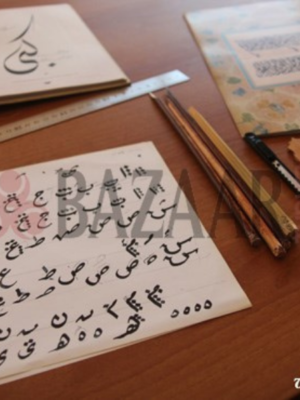 Calligraphy Workshops In Istanbul95,00 €
Calligraphy Workshops In Istanbul95,00 € -
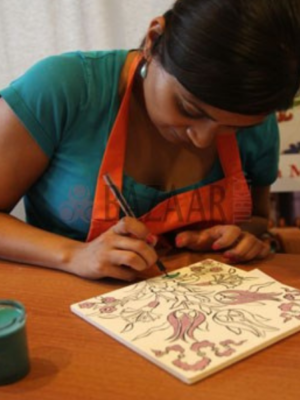 Turkish Tile Ceramic Painting Workshops In Istanbul75,00 €
Turkish Tile Ceramic Painting Workshops In Istanbul75,00 € -
Product on sale
 Turkish Marbling Ebru Workshops in istanbulOriginal price was: 75,00 €.55,00 €Current price is: 55,00 €.
Turkish Marbling Ebru Workshops in istanbulOriginal price was: 75,00 €.55,00 €Current price is: 55,00 €.

